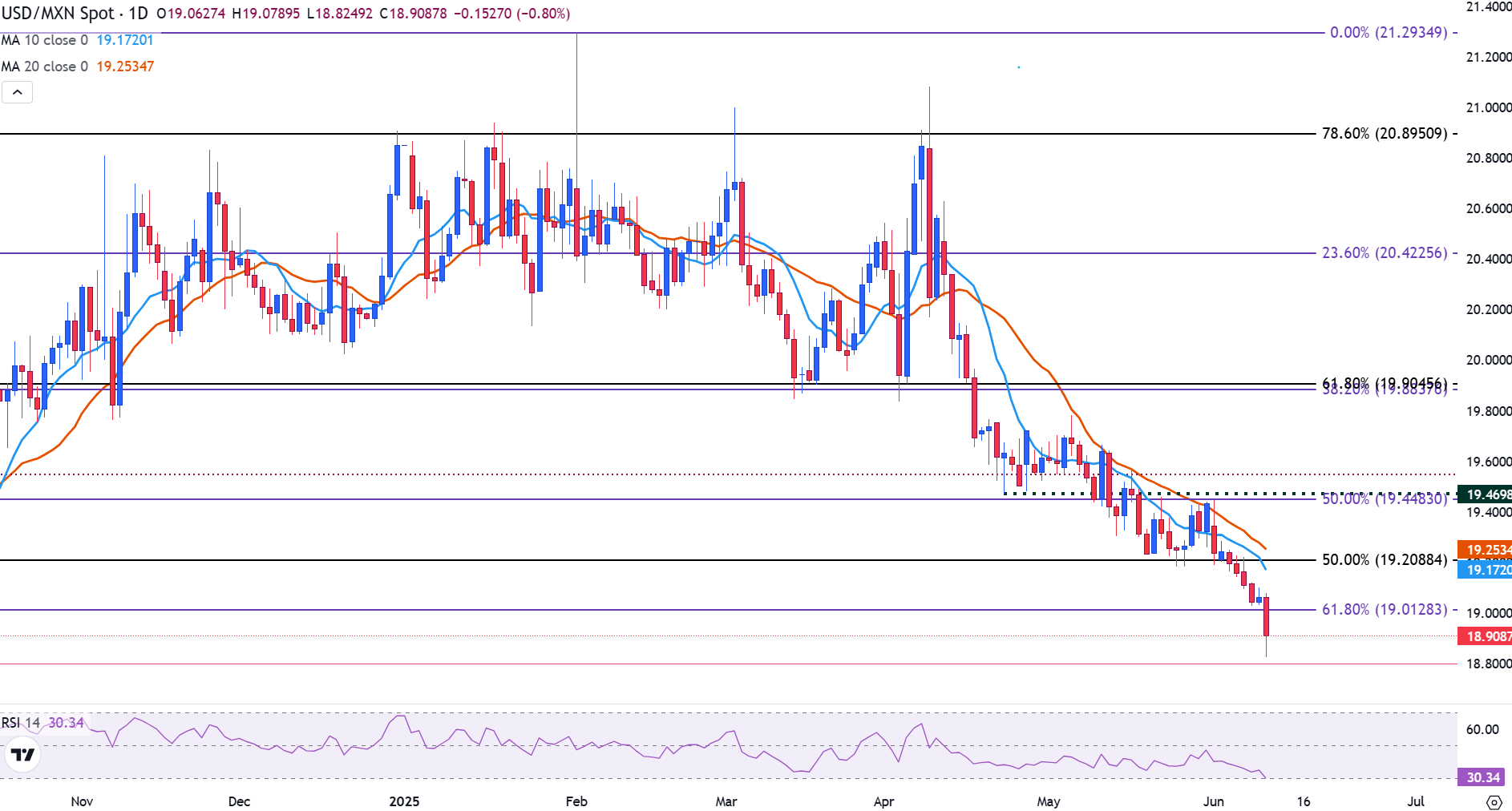Mexican Peso strengthens to 10-month highs on a weaker USD
- USD/MXN drops to 10-month lows as the US Dollar extends losses.
- US–Mexico trade talks are ongoing, with both nations reportedly engaged in advanced discussions.
- Fiscal uncertainty in the US weighs on investor confidence and the Greenback.
The Mexican Peso (MXN) is trading at its strongest level in 10 months against the US Dollar (USD) on Wednesday, supported by improving risk sentiment and ongoing trade negotiations between Mexico and the United States.
At the time of writing, USD/MXN is hovering near 18.90, extending its multi-week downtrend as investors respond to shifting fiscal and trade dynamics.
US Treasury Secretary Scott Bessent’s testimony before the House Ways & Means Committee has brought US fiscal policy back into focus, with lawmakers debating the sustainability of extending tax cuts and introducing so-called “revenge tax” tariffs targeting foreign companies. The fiscal uncertainty, combined with structural deficits, is weighing on the US Dollar broadly.
Meanwhile, US–Mexico trade talks are ongoing, with both nations reportedly engaged in advanced discussions to ease the 50% tariffs imposed by the US on global steel imports earlier this month.
A quota-based system is under consideration, which would allow a defined volume of Mexican steel to enter the US at a reduced tariff rate or duty-free.
However, no formal framework has been finalized, and critical details — including quota size and rate thresholds — are still under negotiation.
Tensions escalated after the tariff rate was raised from 25% to 50% on June 4, prompting Mexico to file for an exemption last Friday.
Officials have warned of retaliatory tariffs if no agreement is reached in the coming days, keeping market participants alert for headline-driven volatility.
Mexican Peso daily digest: Key market movers
- President Donald Trump announced on Truth Social on Wednesday that “Our deal with China is done, subject to final approval with President Xi and me.” He said the US would impose 55% tariffs on Chinese goods, while China would keep its 10% tariff on US goods.
- The US Consumer Price Index (CPI) came in softer than expected on Wednesday. Headline inflation rose 2.4% YoY in May, slightly below the 2.5% forecast and up from April’s 2.3%.
- The core CPI, which excludes food and energy, remained steady at 2.8%, missing expectations of a rise to 2.9%. On a monthly basis, the CPI increased by just 0.1%, undershooting the 0.2% estimate, while the core CPI also rose by 0.1%, sharply below the 0.3% forecast.
- Mexico’s Industrial Output data on Wednesday showed a monthly increase of 0.1% in April after a 1.2% contraction in March. The annual rate showed a 4% contraction, after a 1.9% rise in March.
- Mexico’s inflation data on Monday rose to 4.42%, exceeding Banxico's 3% ±1% target, prompting caution.
- However, in a poll published by Reuters on Wednesday, the majority of analysts still expect a 50 bps rate cut at the June 26 meeting, which would bring the benchmark rate down to 8.0% despite the inflation uptick.
USD/MXN breaks below 19.00 psychological support
The Mexican Peso extended its rally against the US Dollar on Wednesday, with USD/MXN falling below critical support at the 61.8% Fibonacci retracement of the July–February rally at 19.01, confirming a bearish continuation pattern. The pair is now trading near 18.90, marking its lowest level since August 2024, and down nearly 3% this month.
This latest move lower follows repeated rejections at the 10-day and 20-day Simple Moving Averages (SMA), currently at 19.17 and 19.25, which have acted as dynamic resistance since early May. With momentum firmly to the downside, the Peso continues to outperform amid supportive macro sentiment and optimism around a potential US–Mexico trade resolution.
A decisive daily close below 18.60 could pave the way toward 18.40, with downside momentum likely to accelerate if US Treasury yields retreat further or if Banxico signals confidence in easing policy without jeopardizing inflation control.
That said, short-term bullish rebound risks are emerging, with the Relative Strength Index (RSI) hovering near 30, indicating oversold conditions that may trigger consolidation or a corrective bounce. A recovery above 19.01 would help neutralize immediate bearish momentum, but a sustained break above the 20-day SMA at 19.25 is required to signal a broader reversal. If that level is cleared, additional upside targets come into view at 19.44 and 19.57, where key Fib levels and moving averages converge.
USD/MXN daily chart

Mexican Peso FAQs
The Mexican Peso (MXN) is the most traded currency among its Latin American peers. Its value is broadly determined by the performance of the Mexican economy, the country’s central bank’s policy, the amount of foreign investment in the country and even the levels of remittances sent by Mexicans who live abroad, particularly in the United States. Geopolitical trends can also move MXN: for example, the process of nearshoring – or the decision by some firms to relocate manufacturing capacity and supply chains closer to their home countries – is also seen as a catalyst for the Mexican currency as the country is considered a key manufacturing hub in the American continent. Another catalyst for MXN is Oil prices as Mexico is a key exporter of the commodity.
The main objective of Mexico’s central bank, also known as Banxico, is to maintain inflation at low and stable levels (at or close to its target of 3%, the midpoint in a tolerance band of between 2% and 4%). To this end, the bank sets an appropriate level of interest rates. When inflation is too high, Banxico will attempt to tame it by raising interest rates, making it more expensive for households and businesses to borrow money, thus cooling demand and the overall economy. Higher interest rates are generally positive for the Mexican Peso (MXN) as they lead to higher yields, making the country a more attractive place for investors. On the contrary, lower interest rates tend to weaken MXN.
Macroeconomic data releases are key to assess the state of the economy and can have an impact on the Mexican Peso (MXN) valuation. A strong Mexican economy, based on high economic growth, low unemployment and high confidence is good for MXN. Not only does it attract more foreign investment but it may encourage the Bank of Mexico (Banxico) to increase interest rates, particularly if this strength comes together with elevated inflation. However, if economic data is weak, MXN is likely to depreciate.
As an emerging-market currency, the Mexican Peso (MXN) tends to strive during risk-on periods, or when investors perceive that broader market risks are low and thus are eager to engage with investments that carry a higher risk. Conversely, MXN tends to weaken at times of market turbulence or economic uncertainty as investors tend to sell higher-risk assets and flee to the more-stable safe havens.

